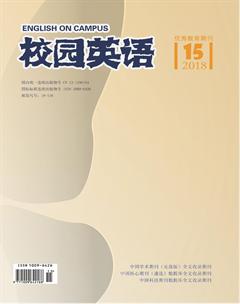Exploring Factors in L2 Reading (English as Second Language Reading) and Pedagogical Implications for ESL Reading in Classroom
王薇
【Abstract】In recent years, there have been a growing number of researches of L2 (Second Language) Reading. These studies suggest a few major factors in L2 reading through reviewing and laying out some key recent research data and results home and abroad. The factors included in this paper are WM (working memory) and L1 literacy. Based on these results, it then proposes classroom teaching implications in ESL reading.
【Key words】L2(Second Language)Reading;cognitive process
Working Memory
Second language learning is related to various kinds of cognitive processes among which working memory is gaining growing attention from researchers in the field. Working memory is defined as a system with the function of storing and processing information and also includes carrying out cognitive tasks like comprehension. Therefore, for some researchers, working memory is considered to be one the effect of WM (β =299) is relatively limited. .
L1 literacy
The role of L1 literacy in L2 reading did not capture any attention until the 1990s. In recent years, researchers began to realize and bring focus on the impact of L1 literacy in L2 reading comprehension (Bernhardt, 2005; Koda, 2007). According to Linguistic Interdependent Hypothesis, L1 and L2 language skills share many similarities and rely on each other. The hypothesis upholds that L1 lays a solid foundation for L2 reading development, (as cited by Jiang,2011). This means that language transfer may be helpful to develop reading skills.
Shibasaki, Tokimoto, Ono, Inoue & Tamaoka, (2015) also investigated the role of L1 literacy in their research by using the Japanese literacy tests as research method. Via means of multiple choices, all the participants took the vocabulary and reading comprehension tests in their L1 (Japanese). The results were shown clearly in Table 1 in L2 text comprehension in specific field(with β =373, p<.01) and in general comprehension (β =008 , ns). It implies that L1 literacy may promote predicting L2 reading on a specific topic. Skilled L1 readers achieved better results of learning L2 reading despite insufficient knowledge of some topics.
On the other hand, not all the research results confirm the important role of L1 literacy in L2 reading. Jiang (2011) conducted a study of 246 grade-one non-English major undergraduates in China to explore the impact of L1 literacy. The Chinese and English tests used in Shanghai college-entrance examination were administrated. The result shows that L1 literacy only accounted for 6% of variance, which means that L1 literacy contribute less to L2 reading compared to other factors (with L2 proficiency contributing 27%-35%). One possible reason for the result is that Chinese orthography is different from that of English and little morphological similarities exist between two languages.
Pedagogical implications for ESL reading
As the analysis reveals, these factors are considerably conducive to L2 reading and may lay a dynamic base to employing effective teaching strategies. Currently, some teachers hold the belief that dictionaries and additional tools for reading should be banned in ESL reading classrooms. However, as analyzed in the review, WM has an impact on L2 reading, which may indicate that some higher WM readers will outperform the lower ones when doing the same reading task. This may lead to the anxiety and negative attitude of the low-span readers. Therefore, teachers could allow students to employ some tools such as dictionaries to assist their reading comprehension.
Additionally, the results discussed in this paper show that WM differs on inferential comprehension in reading. This may suggest that teachers need to design the inferential comprehension questions carefully to avoid over-workload on WM capacity. Since inferential tasks involves certain cognitive demands internally, tasks like free recall requires higher memory ability to fulfill..
Furthermore, it is worth noticing the role of L1 in English classrooms. In the past few decades, an increasing number of English educators promoted the English-medium instruction at earlier stages of learners. However, it may be ineffective for beginners to read in full English if their L1 has not been fully developed. Consequentially at initial learning stages teachers may consider focusing mostly on L2 knowledge aspects such as vocabulary and grammar to facilitate better teaching outcomes. When students reach certain English level, teachers may guide them to read by transferring their L1 kills. Nevertheless, the criteria of crossing the ‘threshold is ambiguous and more studies should be done on when is it appropriate to start focusing on reading comprehension.
Conclusion
This paper reviewed the most recent research on factors that impact L2 reading.. As ESL teachers, we may design reading activities to stimulate content schema of our students and also avoid assigning overload reading tasks due to limited working memory. It is hoped that teachers and leaners may manage reading comprehension by reviewing these factors and implications in ESL reading.
References:
[1]Alptekin,C.,&Er;?etin,G.(2011).Effects of working memory capacity and content familiarity on literal and inferential comprehension in L2 reading.Tesol Quarterly,45(2),235-266.
[2]Bernhardt,E.(2005).Progress and procrastination in second language reading.Annual review of applied linguistics,25,133-150.
[3]Horiba,Y.,&Fukaya;,K.(2015).Reading and learning from L2 text:Effects of reading goal,topic familiarity,and language proficiency.Reading in a Foreign Language,27(1),1.
[4]Hood,S.,Solomon,N.,&Burns;,A.(1996).Focus on reading.National Centre for English Language Teaching and Research,Macquarie University,Sydney,New South Wales,Australia 2109.
[5]Jiang,X.(2011).The role of first language literacy and second language proficiency in second language reading comprehension.Reading Matrix: An International Online Journal,11(2).
[6]Koda,K.(2007).Reading and language learning:Crosslinguistic constraints on second language reading development.Language learning,57(s1),1-44.
[7]Shibasaki,H.,Tokimoto,S.,Ono,Y.,Inoue,T.,&Tamaoka;,K.(2015).English Reading Comprehension by Japanese High School Students:Structural Equation Modeling including Working Memory and L1 Literacy.Open Journal of Modern Linguistics,5(05),443.

